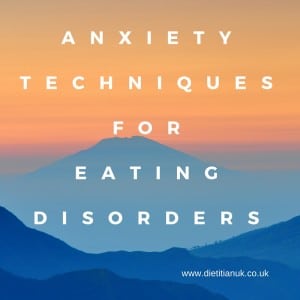Anxiety is one of the biggies when you are working on recovery from an eating disorder. I’ve worked through this with many clients: either whilst they are eating, after a meal or whilst choosing a meal. It can feel totally overwhelming and be quite debilitating. So you need tools available to help you deal with those consuming anxious moments. One thing I alway like to remind people is that anxiety is a natural body response. It may feel like it will overtake you and spiral out of control, but it has to peak and then lessen. Give it 10-20 minutes to pass.
Distraction
Find something that can change your focus. If you are eating you may need someone to start a conversation, the radio may help or watching a candle burn.
If it is away from a mealtime then crafty activities, a good book, a bath or a phone call to a friend could help. Write out a list of things to try out.
Do a Body Scan
A Body Scan is a a great way to reconnect to your body. In moments of anxiety your parasympathetic nervous system can take over, dry mouth, heart beating faster, harder to swallow, feeling hot, a pounding head, tunnel vision – none of it will help when you are trying to eat or to relax after a meal. By working through your body from feet to head you cab bring your awareness back to your body and reduce the anxiety.
Here is a free video version from Elisha Goldstein.
I particularly like progressive muscle relaxation, probably because it is a more active form or relaxation so I have something to do! It works by tensing the muscles in a body part, holding for 30 seconds and then releasing. This leads to a sense of relaxation in that area.. The whole process makes your think about your body and not that anxious event and helps you slow down your breathing too.
Here is a useful script you can use.
Or you can just work from your toes through each muscle you can think of going up to your jaw. Or pick large muscle groups such as your fists, feet, legs, jaw and just do those for a few minutes.
Being Barefoot
Walking barefoot can be a good exercise in thinking about movement, feelings and breathing. Slowly walk around on difference surfaces, working slowly through the foot and focusing on using as many of the small muscles in the foot as possible. Use deep breathing through the ribcage whilst you walk.
Try using a tennis ball to massage and release through your feet first to increase the amount of movement through your feet.
Mindfulness
I often ask clients if they have tried mindfulness. Some people love it and others struggle with it. If you haven’t tried it then good apps include Headspace and Breathworks. It can take time to really get your focus and practise will improve it. Try and find a set time to practise each day, even if it is only 5 minutes.
Breathing
I know this is something we all do, all of the time, but there are some good breathing techniques that can help reduce anxiety. Deep breathing reduces the fight/flight response that occurs when you are stressed. So simply focusing on your breath and slowing it down can help. When you are sat eating and the anxiety starts to mount up, threatening to overwhelm you, try refocusing on your breathing.
In Pilates we use thoracic breathing, where you bring yourself into a neutral posture – stacking your ribcage over your pelvis, breath in deeply expanding through the chest and breath out letting the chest fall back. It always amazes me that just deep breathing uses the right muscles can make a difference.
Another one I like is square breathing – think about or look at a square. Breathing in for 4, hold for 4, breath out for 4 and hold for 4. The counting can be helpful and you can do this without anyone noticing.
